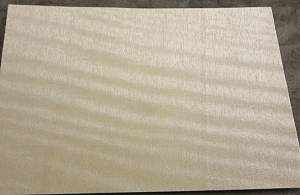Rolls would work, but are probably overkill. In my case I bought a small sheet of the cheapest light colored veneer I could find on eBay, which happened to be anigre wood. I still have most of it. I've used it to fill gaps, make wedge shaped and flat shims...and most recently to fill the the fret slots after turning a fretted bass into a fretless.

I got a piece that was about 1x2 feet that is turning out to be a lifetime supply ;-)
Cut it to size (slightly large) with scissors, glue in, and sand off any excess.
Thank Simon for the idea...he turned me on to it.
You can get something that matches your guitar wood too. Or you can get sampler packs with a variety of woods. I use it in places that don't show so it doesn't matter much, but anigre turns out to look a lot like maple, and takes glue well, so it might work for you, and it's quite cheap (which always appeals to me).








 Reply With Quote
Reply With Quote




